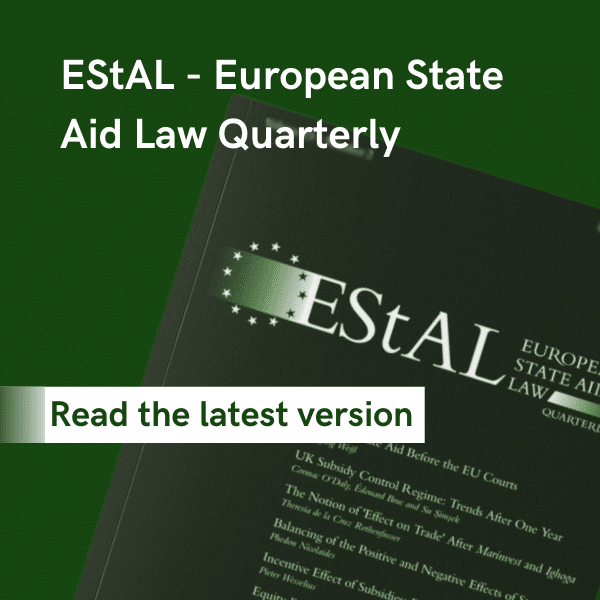
A private investor always takes into account all available information before it makes any investment. Similarly, a private creditor takes into account all available options for recovering the largest possible amount of the money that is due. Such options may include different legal procedures. In assessing alternative options, a private creditor considers not only the amount that may be recovered, but also the complexity and duration of each possible procedure.
Introduction
On 16 March 2016, the General Court delivered a judgment in the latest, but not the last, episode in a 12-year saga. Its judgment in case T‑103/14, Frucona Košice v Commission annulled Commission decision 2014/342 and will certainly keep the dispute between Frucona Košice and the Commission running for at least a couple of years longer.[1]
Although the judgment is interesting for what it says about the application of the private creditor test, the whole case from its inception in 2004 to the current court ruling highlights the consequences of misunderstanding the concept of State aid by national authorities, on one side, and of sloppy reasoning by the Commission, on the other.
Background
Frucona Košice [FK] is a Slovak company which produced spirits. Between November 2002 and November 2003, it benefited from several deferrals of payment of tax debts made up of excise duties. Those deferrals were granted to it after it provided financial guarantees to its local tax office. However, as a result of financial difficulties, FK was unable to pay the excise duties and it could not obtain further deferral of the payment of those excise duties.
In March 2004, FK filed an application in a local court proposing to its creditors to pay each of them 35% of the amount of the sum that it owed to them. In July 2004, the FK’s creditors, including the local tax office, accepted the proposed arrangement.
However, in October 2004, the local tax office indicated to FK that that arrangement, according to which a part of the tax debt did not have to be repaid, constituted State aid, which was subject to the approval of the Commission.
After receiving a complaint and after Slovakia submitted a formal notification asking the Commission to approve the aid as rescue aid to a company in difficulty, in June 2006, the Commission adopted decision 2007/254 according to which the aid was incompatible with the internal market and had to be recovered.
In January 2007, FK appealed the Commission decision before the General Court. In December 2010, the General Court in case T‑11/07, Frucona Košice v Commission rejected the appeal. Then FK appealed before the Court of Justice which in January 2013 in case C‑73/11 P, Frucona Košice v Commission set aside the judgment of the General Court.
The Court of Justice held that the Commission failed to take into account, in the assessment of the private creditor test, the duration of the bankruptcy procedure. Following the judgment of the Court of Justice, the Commission adopted a new decision 2014/342 repealing its previous decision and correcting the error identified by the Court of Justice. The new Commission decision also meant that the General Court found, in case T‑11/07 RENV, that there was no longer any need to rule on the action for annulment.
In its new decision the Commission examined whether the local tax office was justified to give up 65% of its claim, given that the position of the tax office was unusually strong because it held more than 99% of all registered claims. Moreover, those claims could be satisfied at any time during the bankruptcy procedure from the sale of secured assets.
The new judgment of the General Court
First, as is standard practice, FK raised a plea concerning procedural issues and in particular whether the Commission should have opened the formal investigation procedure. The plea was dismissed by the General Court.
In a second plea for annulment, FK argued that the Commission decision was vitiated by an error of law on the grounds that the Slovakian measure should not have been classified as State aid, regardless of how Slovakia notified the measure to the Commission. After all the concept of State aid is an objective concept. [Here the General Court cites extensively C‑124/10 P, Commission v EDF.]
The General Court first recalled that the case law requires the Member State which claims that it is acting as a private investor to show “97 […] clearly that, before or at the same time as conferring the economic advantage at issue, the Member State concerned took the decision to make an investment, by means of the measure actually implemented, [and] to produce evidence showing that the decision is based on economic evaluations comparable to those which, in the circumstances, a rational private investor in a situation as close as possible to that of the Member State would have had carried out, before making the investment, in order to determine its future profitability. By contrast, economic evaluations made after the advantage was conferred, a retrospective finding that the investment made by the Member State concerned was actually profitable, or subsequent justifications of the course of action actually chosen do not suffice to show that, before or at the same time as conferring the advantage, the Member State took that decision as a shareholder.”
But the burden of proof lies with the Commission. “98 If the Member State concerned provides the Commission with the requisite evidence, it is for the Commission to carry out a global assessment, taking into account — in addition to the evidence provided by that Member State — any other relevant evidence enabling it to determine whether the Member State took the measure in question in its capacity as shareholder or as a public authority.”
Then the General Court clarified that “103 the Commission could not draw, from the mere classification of the disputed measure as State aid by the Slovak Republic, the conclusion that that measure actually constituted such aid.”
Even, for whatever reason, a Member State does not claim to have acted as a private investor or private creditor, the Commission may not “109 dispense with an examination of that test or consider it to be inapplicable. On the contrary, the private creditor test may be relied on by the recipient of the aid.” “111 The private creditor test is not an exception which applies only if a Member State so requests […] where it is applicable, that test is among the factors which the Commission is required to take into account for the purposes of establishing the existence of such aid.”
It is clear that the Commission is required to establish whether a public measure can satisfy the private investor or private creditor test even when a Member State does not formally notify a measure as non-aid. But when a measure is claimed either by a Member State or a beneficiary to satisfy the private investor or private creditor test, that claim must be proven on the basis of objective and verifiable evidence.
In the case of FK, although Slovakia did not make that claim, FK did. Therefore the General Court found that “117 the Commission cannot infer from the mere fact that the Member State considered that the contested measure constituted State aid and did not rely on the private creditor test that was inapplicable in the present case.” “127 Therefore, in so far as […] the contested decision contains the conclusion that that test is inapplicable in the present case, the contested decision is vitiated by an error of law. However, since the Commission examined that test on the merits, that error is not, by itself, capable of justifying the annulment of the contested decision.”
Do you know we also publish a journal on State aid?

The European State Aid Law Quarterly is available online and in print, and our subscribers benefit from a reduced price for our events.
The General Court then turned its attention to the third plea, alleging errors of fact and of law vitiating the conclusion that the bankruptcy procedure was more advantageous than the arrangement procedure. It should be noted that Slovakia could choose between three different procedures or options: the debt reduction arrangement, the bankruptcy procedure that was open to any creditor and a tax procedure that was available only to the tax office.
According to the Court, the payment facilities arranged with the tax office would “132 constitute State aid for the purposes of Article 107(1) TFEU where, […], the recipient undertaking would manifestly not have obtained comparable facilities from a private creditor who is in a situation as close as possible to that of the public creditor and is seeking to recover sums due to it by a debtor in financial difficulty.” “134 All information liable to have a significant influence on the decision-making process of a normally prudent and diligent private creditor, who is in a situation as close as possible to that of the public creditor and is seeking to recover sums due to it by a debtor experiencing difficulty in making the payments, must be regarded as being relevant.” “135 In addition, where, as in the present case, for the purposes of recovering the sums owed to it, a normally prudent and diligent private creditor […] would have had to choose between several procedures, it would have had to weigh up the advantages and disadvantages of each of those procedures in order to identify the more advantageous alternative.”
“136 That choice of the private creditor is influenced by number of factors, including the creditor’s status as the holder of a secured, preferential or ordinary claim, the nature and extent of any security it may hold, its assessment of the chances of the firm being restored to viability, as well as the amount it would receive in the event of liquidation, as well as the risks of seeing its losses increase. The decision reached by the private creditor is also liable to be influenced significantly by the duration of the procedures, since it postpones the recovery of the sums due and might thus affect, in the case of lengthy procedures, inter alia, their value.”
“137 It follows that, in the present case, the Commission had to ascertain whether, in the light of those factors, […] a normally prudent and diligent private creditor … would manifestly not have accepted the proposed arrangement. For that purpose, in order to identify the more advantageous alternative, it had to compare, on the basis of the interests of a private creditor, the advantages and disadvantages of each of those procedures.” “139 The burden of proof that the conditions for applying the private creditor test have been fulfilled is borne by the Commission.” This statement is repeated at several points in the judgment. For example, later on the Court reiterated that “269 where it appears that the private creditor test might be applicable, the Commission is under a duty to ask the Member State concerned to provide it with all relevant information enabling it to determine whether the conditions governing the application of that test are met. Therefore, the burden of proof that the conditions of the private creditor test have been fulfilled is borne by the Commission.” But “140 the Commission cannot be criticised for not taking into account matters of fact or of law which […] were not [submitted to it]”.
The Court then assessed the merits of the Commission’s conclusion that a private creditor would not have accepted the arrangement in question. “147 That conclusion was based on an assessment of the likely amount which the tax office would have been able to obtain in a bankruptcy procedure and of the duration of that procedure compared with the amount proposed under the arrangement.” That is, the Commission took the view that the likely amount that the local tax office would have been able to obtain in a bankruptcy procedure would have been considerably higher than that obtained under the arrangement in question.
The Commission considered that the duration of the bankruptcy procedure would not have influenced the decision of a private creditor in a significant way, given that the tax office as a secured creditor could have obtained revenue at any time by selling the assets that had been put up as collateral.
The General Court found that the Commission, acting in line with the requirement of the case-law, “152 carried out an analysis of the advantages and disadvantages of the bankruptcy procedure compared with the arrangement procedure, taking into account in particular the likely proceeds from a sale of the applicant’s assets in the context of the first procedure and the effect of the likely duration of that procedure, as well as the local tax office’s status as a secured creditor.”
However, because the proceeds from sale of assets pledged as collateral is generally less than the initial value of those assets, a discount factor is normally applied to derive the revenue that can be realistically obtained from a forced sale. In this case, the General Court found that the Commission provided “173 no explanation regarding the liquidation factors used to determine the maximum possible proceeds from a sale of the applicant’s assets in the context of a bankruptcy procedure. “181 The Commission applied liquidation factors amounting, for each of those asset items, to 97, 52, 59 and 100% respectively”. But “185 the Commission did not carry out any methodological or economic analysis and did not request, during the administrative procedure, additional information intended to verify and substantiate the [liquidation factors]”. For this reason, the General Court concluded that “196 the evidence in the administrative file does not substantiate, to the requisite legal standard, the liquidation factor applied by the Commission for the purpose of assessing the proceeds from the sale of the applicant’s non-current assets.”
With respect to the duration of the bankruptcy procedure and its effect on the choice of the private creditor, the Commission considered that the duration would not have had a significant influence on the decision of a private creditor. According to the Commission, regardless of the duration, the tax office, as a secured creditor, could have obtained revenue at any time from sale of assets that were put up as collateral. However, because it had already been found that the liquidation factors used by the Commission were unsubstantiated, the General Court concluded that, since the sums that supposedly could have been recovered were uncertain, the Commission could not be certain that the duration of the bankruptcy procedure was as insignificant as the Commission had presumed.
With respect to another plea, alleging errors vitiating the conclusion that the tax execution procedure was more advantageous than the arrangement procedure, the General Court first noted that the form of the aid was irrelevant [as in the EDF v Commission judgment]. In the present case, all parties agreed that only the tax office had the option of the tax execution procedure. Nonetheless, the General Court observed that “253 the mere fact that the tax execution procedure was not accessible to a private creditor does not preclude an analysis of the private creditor test for the purpose of comparing that procedure with the arrangement procedure. It does not preclude the verification of the economic rationality of the local tax office’s decision to opt for the arrangement procedure.” “268 The Commission had to ascertain in the present case whether, […], for the purposes of recovering the sums owed to it, a normally prudent and diligent private creditor in a situation as close as possible to that of the Slovak authorities would manifestly have preferred the tax execution procedure to the proposed arrangement. For that purpose, in order to identify the more advantageous alternative, the Commission had to compare, on the basis of the interests of a private creditor, the advantages and disadvantages of each of those procedures.” Indeed, the Commission had “272 concluded that tax execution would have led to a higher return than the arrangement and that a private creditor, had he had the possibility, would have preferred tax execution to the proposed arrangement.”
But again the General Court found that the Commission committed an error because it took into account unsubstantiated liquidation factors. In addition, the General Court faulted the Commission because it “279 merely assumed that [the tax execution procedure] would be conducted in a speedy manner, in particular when compared with the bankruptcy procedure, since it was initiated and controlled by the authorities itself. However, the Commission did not carry out any assessment of that duration, whether in the circumstances of the present case or, at the very least, on average in the light of the stages of the procedure as established by Slovak law. In addition, in its pleadings, the Commission acknowledges the inadequacy of the information available regarding the duration of a tax execution procedure.” The General Court stressed that it was important to note that “280 the duration of the procedures constitutes a factor which is liable to have a significant influence on the decision-making process of a private creditor”.
For all of the reasons identified above, the General Court annulled Commission decision 2014/342. The Commission will now have to re-open the case and find out how the various procedures can be executed under Slovak law. It will not be surprising if in the end it takes more than 15 years before it is finally settled whether FK received any incompatible aid.
Conclusions
For the application of the private creditor test, procedures are important. The reasoning of the Commission in the various stages of this case was in principle correct. But that was not enough. The Commission should have explained all the factors it took into account, such as the liquidation factor, and should have backed up its views on the length and complexity of the various legal procedures with credible evidence from actual practice.
—————————————————-
[1] http://curia.europa.eu/juris/document/document.jsf?text=&docid=175134&pageIndex=0&doclang=EN&mode=lst&dir=&occ=first&part=1&cid=503910



